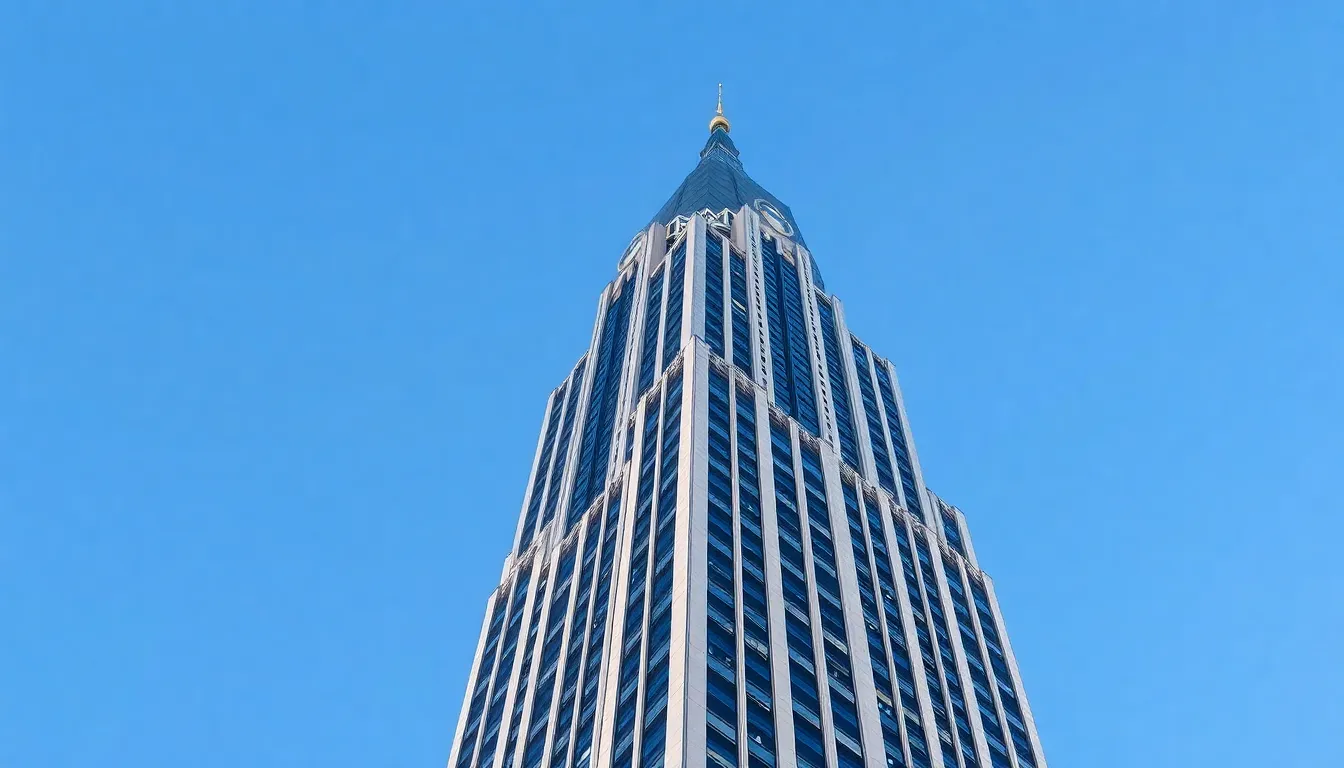The Chrysler Building stands tall and proud, a shining example of Art Deco architecture that can make anyone weak in the knees. But behind its iconic spire lies a story of ambition, innovation, and a dash of good old-fashioned rivalry. Built during the roaring twenties, this skyscraper wasn’t just a workplace; it was a statement—like wearing a tuxedo to a casual brunch.
Table of Contents
ToggleOverview of the Chrysler Building
Construction of the Chrysler Building started in 1928 and completed in 1930. This iconic skyscraper soars to a height of 1,046 feet, making it one of the tallest buildings in New York City. Designed by William Van Alen, its architectural style embodies Art Deco, characterized by bold geometric forms and elegant detailing.
Unique features adorn the building’s exterior. A distinctive crown, made of stainless steel, showcases a series of radiating arches. Illuminating the skyline, the crown features a fluted design, enhancing its prominence during nighttime.
Particular elements reflect the ambitions of the era. The building’s ornamental details incorporate automotive motifs, symbolizing Chrysler’s legacy in the automobile industry. Gargoyles and eagles, prevalent on lower levels, exemplify the fusion of modern technology and traditional craftsmanship.
Building the Chrysler Building involved innovative techniques for its time. A lightweight steel frame allowed for quick construction, enabling Van Alen to erect the structure rapidly. Ingenious use of setbacks broke the monotony of its form, giving it a distinctive silhouette against the sky.
Current assessments recognize the Chrysler Building’s significance in architectural history. It continues to attract visitors and architectural enthusiasts. Recognized as a New York City landmark, it remains an enduring symbol of American ingenuity and artistic expression.
Notable events marked its history. Initially, it served as office space for various businesses. Today, it stands as a testament to the creativity of the 1920s, intertwining art and architecture in a breathtaking display.
Historical Context

The Chrysler Building emerges from a dynamic period in American history, characterized by rapid urban development and economic ambition. Its construction during the late 1920s coincided with significant advancements in architecture and engineering.
Economic Factors Influencing Construction
Investment in skyscraper projects thrived thanks to a booming economy. The stock market experienced unprecedented growth, fueling construction costs and enabling ambitious architectural designs. Chrysler Corporation’s success played a crucial role, providing the financial resources needed for the project. In addition, competition among businesses to establish iconic structures spurred developers to push boundaries, resulting in innovations like the lightweight steel frame. This economic backdrop not only supported the building’s ambitious height but also highlighted the era’s commitment to progress and modernity.
Architectural Trends of the Era
Art Deco defined architectural aesthetics in the 1920s, showcasing glamour and luxury through bold geometric shapes. This style emphasized intricate details and reflected cultural aspirations of modernity. Chrysler Building’s design incorporated such trends with its striking stainless steel crown and elaborate motifs. Architects and designers embraced new materials and techniques, allowing for a departure from traditional styles. As a result, the structure became a hallmark of the era, signaling a shift toward innovative design philosophies. Each facet of the building tells a story of creativity and ambition that resonated throughout the architectural landscape at the time.
Design and Architecture
The Chrysler Building’s architecture exemplifies the Art Deco style, showcasing both innovation and elegance. This period’s influences contributed significantly to its design.
Influences on the Design
American art movements, particularly Cubism and Futurism, played pivotal roles in shaping the Chrysler Building’s aesthetic. William Van Alen embraced these artistic tendencies, creating a structure characterized by bold geometric lines. The building’s inspiration draws heavily from the automotive industry, reflecting Chrysler’s identity. Features like the streamlined forms and chrome elements echo the era’s fascination with speed and modernity. This blend of influences enabled the Chrysler Building to represent the ambition of its time.
Distinctive Features of the Chrysler Building
Several unique elements define the Chrysler Building, setting it apart from its contemporaries. A prominent stainless steel spire adorns the top, exemplifying the building’s innovative use of materials. Radiating arches at the crown serve both functional and decorative purposes, creating a striking silhouette against the sky. Eagles and gargoyles from Chrysler’s automotive heritage add a touch of craftsmanship to the facade. These distinctive features contribute to the building’s iconic status, highlighting the mastery behind its design.
Construction Process
The construction of the Chrysler Building exemplifies remarkable engineering and innovation. This monumental project included several key phases that ensured its successful completion.
Key Phases of Construction
Site preparation commenced in 1928, clearing the area for the skyscraper. The foundation laid the groundwork, requiring over 300 concrete piles to support its weight. Steel framing progressed rapidly, with workers erecting an average of four floors per week. By 1929, the building surpassed the 77th floor, surprising many with its pace. The installation of the stainless steel crown became the final flourish, completed in just 90 minutes, thereby defining its iconic skyline silhouette.
Challenges Faced During Construction
Adverse weather conditions posed significant challenges during construction. Rain and wind frequently delayed work schedules, affecting productivity. Labor shortages also threatened timelines, as skilled workers often moved to competing projects. Innovative solutions emerged in response; workers utilized prefabrication techniques to streamline assembly and improve efficiency. Additionally, the race to outstrip other buildings created pressure, pushing architects and engineers to collaborate closely. Each obstacle heightened their determination, contributing to the construction’s overall success.
Impact and Legacy
The Chrysler Building holds immense cultural significance and remains a symbol of architectural excellence. Recognized globally, it embodies the spirit of the Art Deco movement. Renowned for its sleek design, it inspires architects and artists alike. The building captures the imagination with its distinctive crown and detailed motifs. Its legacy includes influencing numerous skyscrapers, shaping urban skylines worldwide.
The Chrysler Building today stands as an iconic landmark in New York City. Tourists flock to admire its architectural beauty. Preservation efforts maintain its historical integrity while adapting to modern needs. Inside, original art deco decor still captivates visitors. Additionally, its presence in popular culture reinforces its relevance, appearing in films and literature. As a result, the Chrysler Building endures, symbolizing innovation and creativity in architecture.
The Chrysler Building stands as a testament to the ambition and creativity of its era. Its Art Deco design not only redefined the skyline of New York City but also captured the spirit of innovation that characterized the 1920s.
As one of the tallest buildings of its time, it continues to inspire future generations of architects and artists alike. The blend of modern technology with traditional craftsmanship is evident in every detail, from its iconic crown to its intricate motifs.
Today, the Chrysler Building remains a cherished landmark, attracting visitors who appreciate its architectural beauty and cultural significance. Its legacy endures, reminding us of a time when dreams and designs reached for the sky.


